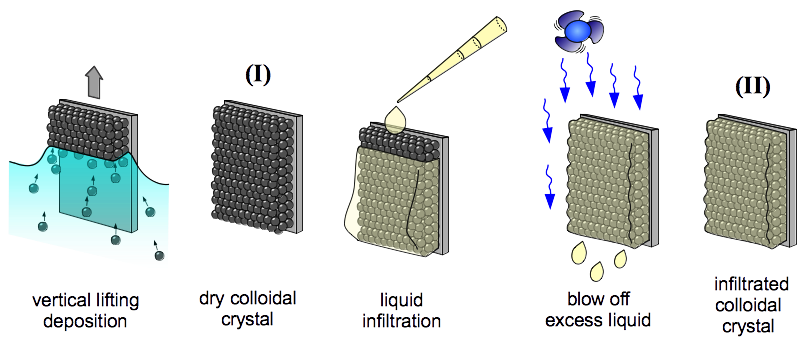Hierarchically Assembled Colloid Structures
Colloidal Crystals (CC) have been attracting substantial attention throughout the last decade. A very convenient method to fabricate CC is based on the self-assembly of monodisperse spherical colloidal particles, like polystyrene latex. In particular by vertical lifting deposition complex colloidal structures with high order and structural hierarchy can be fabricated by simple means even from particle mixtures.
A key feature of the CCs is the periodic change in the dielectric constant, which results in constructive and destructive interact with electromagnetic waves, such as light. This property may prevent light of a particular wavelength and incident angle to propagate through the CCs, leading to the term "photonic crystals". In analogy to the interaction with electromagnetic waves, those materials can also modulate the propagation of acoustic or elastic waves as "phononic crystals". Only recently the presence of two types of hypersonic band gaps in liquid infiltrated face-centered-cubic CCs was measured by spontaneous Brillouin light scattering. In phononic crystals a band gap for acoustic waves of distinct frequency can be caused by the periodic change of the material density (so called Bragg gap) or by the interaction of the vibrational eigenmodes of the constituting spheres with the surrounding medium (so called hybridization gap).
The 3D structure of the CCs can be further utilized as sacrificial template to generate porous networks with inverse opal geometry by filling the interstitial voids with a matrix followed by removal of the templating particles. The resulting interconnected networks will preserve the structural hierarchy of the parent CCs and may be further modified, leading to a broad range of potential applications from oil recovery and water purification to tissue engineering.
Besides the 3D CC structures also 2D ordered colloidal monolayers are of major interest as they serve as masks for nanosphere lithography, which is a powerful tool for nanostructuring of surfaces.

Collaboration Partners:
Prof. Dr. Markus Retsch - University of Bayreuth, Physical Chemistry – Polymer Systems, Universitätsstr. 30, 95447 Bayreuth, Germany
Prof. Dr. Georg Fytas - Foundation for Research and Technology Hellas (FORTH), Institute of Electronic Structure & Laser (IESL), P.O. Box 1527, 71110 Heraklion, Greece - and - Department of Materials Science and Technology, University of Crete, Heraklion, Greece -and - Max Planck Institute for Polymer Research, Ackermannweg 10, 55128 Mainz, Germany
Dr. Nicolas Vogel - School of Engineering and Applied Sciences, Harvard University, 9 Oxford Street, Cambridge, MA 02138, USA
